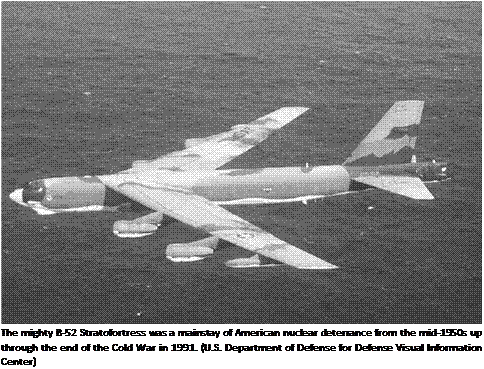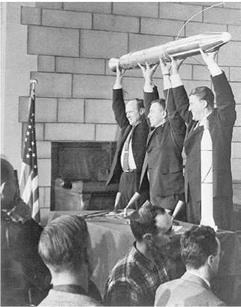1958
JANUARY 1—15 At Cooke Air Force Base, California, the 672nd Strategic Missile Squadron becomes the first Air Force unit to train and deploy the Bomarc interceptor missile. The 864th Strategic Missile Squadron, equipped with Jupiter IRBMs, also becomes operational.
JANUARY 29 In Washington, D. C., the Department of Defense declares it intention to create the National Pacific Missile Range at the Naval Air Missile Test Range, Point Mugu, California. Future long-range weapons will be tested here.
|
The United States had been surprised by the Soviet Union’s Sputnik satellite, and now embraced the new “space race” with a vengeance. (Courtesy NASA/Jet Propulsion Laboratory) |
JANUARY 31 At Cape Canaveral, a Jupiter C rocket carries Explorer I, the first American satellite, into Earth orbit. An onboard experiment designed by James A. Van Allen reveals the existence of a radiation belt around the planet.
FEBRUARY 1 At Warren Air Force Base, Wyoming, the 706th Strategic Missile Wing, the first to deploy Atlas missiles, is activated by the Strategic Air Command (SAC).
FEBRUARY 7 In Washington, D. C., the Department of Defense creates the Advanced Research Projects Agency (APRA) to assume control of the nation’s space exploration program.
FEBRUARY 18 At Tullahoma, Tennessee, the Arnold Research Development Center creates a wind tunnel capable of creating an airflow speed of 32,400 miles per hour for one-tenth of a second.
MARCH 17 At Cape Canaveral, Vanguard I, the nation’s second artificial satellite, blasts off into orbit. This small device carries solar-powered batteries with an anticipated 1,000-year life expectancy, while other data reveals that the Earth possesses a slight pear shape to it.
MARCH 21 At Holloman Air Force Base, New Mexico, a two-stage rocket pushes an unmanned sled to speeds of2,700 miles per hour.
MARCH 26 An Astrodyne rocket motor strapped to an F-100D Super Sabre launches the aircraft from a rail system for the first time. Such a system negates the need for a lengthy runway, although it is never adopted.
MARCH 27 The Advanced Research Projects Agency (ARPA) tasks the Air Force Ballistic Missile System with launching three lunar probes through its existing Thor-Vanguard missile system.
April 2 In Washington, D. C., President Dwight D. Eisenhower proposes a new National Aeronautics and Space Agency (NASA) that would absorb the NACA as well as conduct civilian space programs and military technical initiatives.
April 5 At Cape Canaveral, Florida, an Atlas ICBM is successfully launched by the Air Force, and it travels 600 miles downrange to a designated impact area.
April 8 At Lajes Field, Azores, a KC-135 Stratotanker makes a nonstop, unrefue led jet flight record after covering 10,288 miles from Tokyo, Japan.
May 7 Over California, an F-104 Star – fighter piloted by Major Howard J. Johnson sets a new altitude record of 91,243 feet, very impressive for an air-breathing jet.
May 12 At Colorado Springs, Colorado, the joint U. S.-Canadian North American Air Defense Command (NORAD) becomes operational. It is tasked with defending the continent against enemy aerial attacks.
May 16 An F-104A Starfighter piloted by Captain Walter W. Irwin sets an absolute speed record of 1,404.2 miles per hour.
May 24 The open-cockpit Bell X-14 research plane, cobbled together from parts of a Beech T-34 and a civilian Bonanza, makes its transition flight from vertical to horizontal. It remained an Air Force test bed until 1960, when it was transferred to NASA.
At Holloman Air Force Base, New Mexico, a rocket sled exposes passenger Captain E. L. Breeding to 83 g’s for a fraction of a second.
May 27 At Eglin Air Force Base, Florida, the first operational F-105B Thunder – chiefs are deployed with the 335th Tactical Fighter Squadron.
The McDonnell Douglas YF4H-1 prototype flies for the first time. It enters service as the legendary F-4 Phantom II.
June 3 NACA and Air Force officials
reveal details of an inertial guidance system for the new X-15 rocket research aircraft. This device will assure correct pitch attitude for reentering the atmosphere during high-altitude flights in near space.
June 4 At Cape Canaveral, Florida, a Thor missile is launched from a tactical – type launcher by Air Force crews.
June 16 The Air Force contracts with the Martin Company and the Boeing Company to design and build the Phase I Dyna-Soar boost-glide orbital spacecraft.
June 27 At Cape Canaveral, Florida, the 556th Strategic Missile Squadron makes the first military launch of a Northrop Snark intercontinental missile.
June 30 In Washington, D. C., NACA declares that nearly half of all research it conducts is skewed towards missiles and problems associated with space flight.
July 14—15 In Lebanon, Operation blue bat unfolds as Composite Air Strike Force Bravo transfers 2,000 fully equipped combat troops from camps in West Germany to the Middle East during a period of unrest.
July 26 At Edwards Air Force Base, California, an F-104 Starfighter crash takes the life of Captain Iven C. Kincheloe.
AUGUST 1 Over Johnson Island in the Pacific, a nuclear-tipped ICBM interceptor missile is detonated to assess whether such weapons are practical in neutralizing incoming enemy missiles.
AUGUST 2 An Atlas missile is launched for the first time with a full-power flight profile utilizing both sustainer and boost engines.
AUGUST 6 The Rocketdyne Division, North American Aviation, contracts with the Air Force to design and build a rocket motor capable of producing 1 million pounds of thrust.
In Washington, D. C., Dr. T. Keith Glennan and Dr. Hugh L. Dryden are sworn in as administrator and deputy administrator, respectively, of the new National Aeronautics and Space Administration (NASA).
AUGUST 21 Former general James H.
“Jimmy” Doolittle convenes the final meeting of the National Advisory Committee for Aeronautics (NACA) once NASA is enacted.
AUGUST 23 In Washington, D. C. the Federal Aviation Administration (FAA) is created by Congress to oversee military and civil aviation matters and help locate new airports and missile bases.
September 2 Along the Soviet border with Turkey, Russian MiG aircraft attack and shoot down a C-130 Hercules performing ELINT (electronic intelligence) work.
SEPTEMBER 3—9 In the Pacific, Operation x-ray tango unfolds as F-100 Super Sabres, B-47 Canberras, and C-130 Hercules aircraft are rushed to the Pacific in response to Communist China’s threats to Taiwan. This effective deployment over so wide an area gains a Mackay Trophy.
September 9 A Boeing EB-50 test aircraft launches a Lockheed X-7 ramjet test platform, which accelerates to Mach 4.
SEPTEMBER 16 The North American NA-246 prototype flies for the first time. This six-seat passenger jet enters service as the T-39 Sabreliner.
September 19 The Kaman H-43A helicopter flies for the first time. It enters Air Force service as the Husky, although its twin-rotor design leads to the nickname of “eggbeater.” The H-43A is widely employed by the Tactical Air Command (TAC) as a firefighting and crash recovery helicopter.
September 24 At Cape Canaveral, a Bomarc interceptor missile is launched from commands issued at a control station in Kingston, New York, and destroys an incoming target drone flying a 1,000 miles per hour at an altitude of
48,0 feet.
OCTOBER 26 The Boeing B-52G performs its maiden flight; this version is designed to carry two AGM-28 Hound Dog missiles under its wings.
 |
November 1 The turbine-powered Kaman H-43B performs its maiden flight; it is eventually redesignated the HH-43B.
November 8 At Cape Canaveral, Florida, the third Air Force attempt to launch a lunar probe fails when the third stage of a rocket fails to ignite and the Pioneer 2 falls back to Earth. This is the last lunar shot attempted by the Air Force.
November 28 An Atlas intercontinental ballistic missile undergoes its first operational test launch; the vehicle flies 6,300 miles and lands in a designated area.
December 3 At Pasadena, California, the Jet Propulsion Laboratory is transferred from the California Institute of Technology (Caltech) to NASA at the order of President Dwight D. Eisenhower.
December 16 At Point Mugu, California, a Thor IRBM is launched by the Pacific Missile Test Range for the first time. Another Thor goes up at Cape Canaveral on the same day.
A Military Air Transport Service (MATS) C-133 Cargomaster sets a world payload record by lifting 117,900 pounds to an altitude of 10,000 feet.
December 18—19 Project score unfolds as the Air Force launches its first communications satellite into orbit on an Atlas rocket. A day later it broadcasts a taped message by President Dwight D. Eisenhower, who has the first human voice beamed in from outer space.
December 23 At Cape Canaveral, Florida, the Air Force successfully test launches the first Atlas-C missile.











